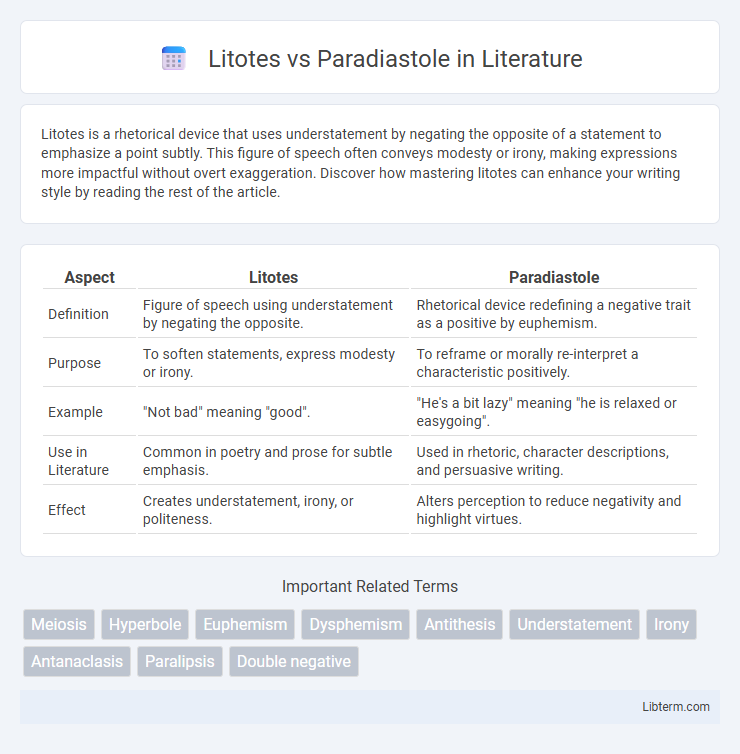Litotes is a rhetorical device that uses understatement by negating the opposite of a statement to emphasize a point subtly. This figure of speech often conveys modesty or irony, making expressions more impactful without overt exaggeration. Discover how mastering litotes can enhance your writing style by reading the rest of the article.
Table of Comparison
| Aspect | Litotes | Paradiastole |
|---|---|---|
| Definition | Figure of speech using understatement by negating the opposite. | Rhetorical device redefining a negative trait as a positive by euphemism. |
| Purpose | To soften statements, express modesty or irony. | To reframe or morally re-interpret a characteristic positively. |
| Example | "Not bad" meaning "good". | "He's a bit lazy" meaning "he is relaxed or easygoing". |
| Use in Literature | Common in poetry and prose for subtle emphasis. | Used in rhetoric, character descriptions, and persuasive writing. |
| Effect | Creates understatement, irony, or politeness. | Alters perception to reduce negativity and highlight virtues. |
Introduction to Litotes and Paradiastole
Litotes is a rhetorical figure of speech that employs understatement by using double negatives or negations to affirm a positive statement, often softening the impact or expressing modesty, such as saying "not bad" to mean "good." Paradiastole, on the other hand, involves redefining a negative trait as a positive or neutral quality through euphemistic language to alter perception, exemplified by describing laziness as "relaxation expertise." Both techniques manipulate language to influence interpretation, but Litotes relies on negation for emphasis, whereas Paradiastole reframes meaning via euphemism and reclassification.
Defining Litotes: Subtle Understatement
Litotes is a rhetorical device that employs subtle understatement by using negation to express a positive attribute, such as saying "not bad" to mean "good." This form of understatement softens the impact of a statement while enhancing its persuasive effect through irony or modest emphasis. Unlike paradiastole, which reinterprets or redefines a term to shift its moral or emotional tone, litotes relies primarily on double negatives or minimal expression to convey nuanced affirmation.
Understanding Paradiastole: Reframing the Negative
Paradiastole is a rhetorical device that reframes a negative trait by presenting it as a positive or neutral quality, often to soften criticism or alter perception. Unlike litotes, which understates by using double negatives (e.g., "not bad" to mean "good"), paradiastole directly redefines an undesirable attribute through euphemistic or mitigating language. Mastering paradiastole enhances persuasive communication by transforming unfavorable descriptions into acceptable or even commendable traits.
Historical Roots and Literary Origins
Litotes and paradiastole both originate from ancient rhetorical traditions, with litotes traced back to classical Greek and Latin literature where understatement was used to convey emphasis through negation. Paradiastole emerged in classical rhetoric as a technique for reinterpreting vices as virtues, often found in Aristotelian and Cicero's works to shape moral or ethical perspectives. Their historical roots lie in the art of persuasion, deeply embedded in the literary origins of Western rhetoric and classical oratory practices.
Key Differences Between Litotes and Paradiastole
Litotes is a figure of speech that employs understatement by using double negatives or negating the opposite to express a positive statement, while paradiastole involves reinterpreting a negative trait as a positive or neutral quality through euphemistic language. Litotes emphasizes minimalism and subtlety in affirmation, often conveying modesty or irony, whereas paradiastole focuses on moral rebranding or reframing character flaws in a more favorable light. The key difference lies in litotes' syntactic negation to soften claims versus paradiastole's rhetorical strategy of redefining terms to affect perception and tone.
Examples of Litotes in Literature and Speech
Litotes, a form of understatement employing double negatives or negation to express a positive, appears prominently in literature and speech, as seen in Shakespeare's "Macbeth" with the phrase "not bad" to imply something good. Mark Twain frequently used litotes to add humor and subtlety, such as in "The Adventures of Tom Sawyer," where he describes a character as "not the sharpest tool in the shed." This device contrasts with paradiastole, which redefines a negative trait by reframing it in a positive light rather than negating it.
Examples of Paradiastole in Texts and Rhetoric
Paradiastole involves the reframing of a negative trait as a positive one, often seen in literature and rhetoric when a character's stubbornness is described as determination or persistence. An example can be found in Shakespeare's plays, where a villain's cruelty is portrayed as strength or resolve to emphasize complexity rather than pure evil. This rhetorical device subtly shifts audience perception by highlighting virtues concealed within apparent faults, contrasting Litotes, which uses understatement to express negation.
Functions and Effects in Communication
Litotes employs deliberate understatement to create emphasis through negation, softening statements while implying stronger or opposite meanings, thus fostering subtlety and irony in communication. Paradiastole reframes a negative trait by redefining it in a positive or neutral light, often serving to mitigate criticism and persuade audiences by altering perception. Both rhetorical devices influence tone and persuasion; litotes tempers intensity while paradiastole reshapes moral judgment, enhancing rhetorical effectiveness in dialogue and argumentation.
Common Misconceptions and Overlaps
Litotes and paradiastole are often confused because both use understatement and positive phrasing to influence perception, but litotes employ double negatives (e.g., "not unhappy") to express affirmation, while paradiastole redefines negative traits as positive virtues (e.g., calling stubbornness "determination"). Common misconceptions arise when litotes are mistaken for simple negation rather than nuanced affirmation, and paradiastole is seen merely as euphemism rather than deliberate moral recharacterization. Overlaps occur when both devices soften criticism, but their rhetorical goals differ: litotes confirm subtly, paradiastole reframes character judgments.
Conclusion: Choosing Between Litotes and Paradiastole
Litotes employs understatement through negation, softening statements to convey modesty or irony, whereas paradiastole reframes negative traits as positive or neutral qualities, often used for rhetorical persuasion. Selecting between litotes and paradiastole depends on the desired tonal effect: litotes suits subtle emphasis and humility, while paradiastole effectively redefines perception and mitigates criticism. Understanding these distinctions enhances precise rhetorical strategies in writing and communication.
Litotes Infographic

 libterm.com
libterm.com